Christopher Columbus - A Complicated History
- Laura

- Oct 12, 2020
- 4 min read
Updated: Feb 9, 2021
Every year with the celebration of Columbus Day, we open up a complicated past. More and more people are choosing to celebrate Indigenous Peoples Day on this day instead. Have you ever wondered why this is? Maybe you find it hard to differentiate between the fact and the fiction when it comes to Christopher Columbus and the native people he met along his travels. Today, I'm going to tell you a bit about Columbus and the Taíno people who he encountered when he resettled the land he found.

Christopher Columbus was born in 1451 in a thriving seaport town in what is present day Italy. Growing up, he read about Marco Polo and his travels to the Indies and he wanted to find the same riches himself. He became an apprentice on a trading ship where he learned how to sail. For eight years, Christopher went to wealthy and powerful people asking them to help him with amassing ships and funds to begin his journey and he eventually went to what it now Spain and talked to Queen Isabella and King Ferdinand. They decided to give Christopher a chance in exchange for the majority of what riches he found and their nations claim of the land he settled. The King and Queen ordered a nearby town to provide ships and supplies for him, and he went about finding a crew. It took 70 days for Christopher and his new crew to travel to another land aboard the Niña, Pinta and the Santa Maria. On October 12, 1492, they arrived in what is now the Bahamas.

Upon his arrival in the Bahamas, he encountered the native inhabitants, the Taíno. These people were shocked by these new people but did welcome them into their homes to sleep and eat. They offered them various goods for trade and were incredibly hospitable. Initially, Christopher and his men were also very kind and they lived together in harmony, but this is not what they had planned. The goal was to take the land for its wealth and enslave the people to work for them. In letters to Spain, Christopher mentioned that these new people were strong, but lacked weapons. They were also not trained to fight, so "with fifty men they can all be subjugated [controlled] and made to do what is required of them".
Within two months, Christopher set up their first fort and it was the beginning of the end for the Taíno culture. By the early 1500s, 85% of the people had died by fighting, suicide, murder and disease. Hundreds were captured and sold as slaves in Europe, others were forced to search for gold and beaten if they didn't find enough, any natives that fought back against Christopher and his men were killed. More and more new settlers inhabited the land, and initially, the King and Queen were pleased. Eventually, it was figured out that this wasn't the Indies that Christopher was trying to settle and the riches were not going to be found here. He was stripped of his role as Governor of the colonies, his men turned against him when they never found unlimigoldted; he became sick and needy. He died in 1506.
The indisputable accomplishments of these journeys were that the worlds were now joined by a traveled route, eventually some of these settlers would inhabit North America, horses were introduced to the native people in the Americas, tobacco was introduced to Europe, and the trade of plants from both the Americas and Europe were now exchanged bringing new food sources to the lands. So many plants were traded that we call this the Columbian Exchange.
While Christopher Columbus did not "Discover" America, we do still celebrate him in much of America. The book, Did Christopher Columbus Really Discover America? And Other Questions About The New World, states it best:
"Behind Columbus's name lie two continents and a nation but also a wave of violence. His legacy is complicated. He was a brilliant sailor but also a ruthless and sometimes dishonest leader. Columbus and the settlers helped shape the modern world but, horrifically, they wiped out the Taíno people. A villain to some, a hero to others, Columbus was a flawed and mortal man. His legacy will never be forgotten"
If you want to do a simple coloring activity for Christopher Columbus, check out this coloring page:
Here is a map of what was known of the world to Christopher and the Europeans at the time of his travels:
You can also use this coloring page to write something you've learned about Christopher Columbus:
I hope this long and complicated history helped to teach you something new of help to dispel some of the myths about the discovery of America for you! I'll be posting some other things about the Taíno people in another post. If you learned anything today, or do any of the activities I post, be sure to use the hashtag #LearningFunWithLaura so I don't miss it!


Comments